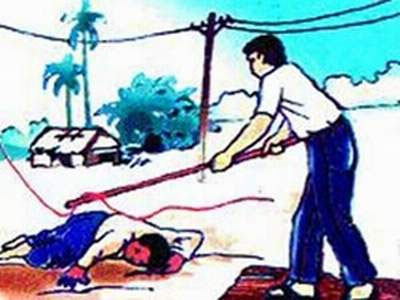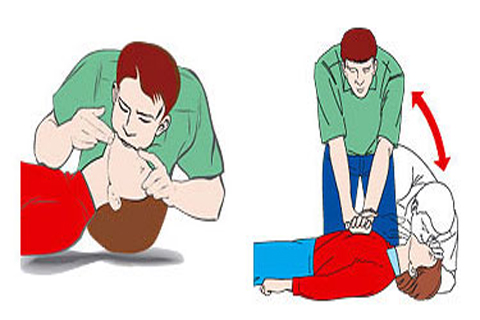First aid when electrocuted
Electric shock accidents often occur suddenly because we accidentally touch the power source or do not follow the rules to prevent accidents when exposed to electricity. If you do not know how to effectively prevent and give first aid, people with electric shock can suffer burns, even death.
Therefore, first aid for people with electric shock is very important in saving victims' lives.
How to first aid the victim when an electric shock occurs
- When detecting an electric shock, it is necessary to quickly separate the victim from the electric current by cutting the circuit breaker. It is possible to use any dry but non-metallic object to push, separate the victim from the current (H1). (Note: Do not use your bare hands, but wear rubber gloves or nylon bags, dry cloths, wear dry shoes or stand on a dry board, use a dry wooden stick to remove the wire).

Use any dry but non-metallic object to push, separate the victim from the current.
- Place the victim in a cool place.
- Check if the victim is breathing or not, apply the cheek to the victim's nose and see if the chest is movable or put into the artery on either side of the victim's neck.
- For unconscious victims with no signs of breathing : artificial respiration and chest compressions in place, until self-breathing or determination of the victim is sure to stop.
+ Artificial respiration: Extending clothes and waistband, cushioning under the neck for head to tilt back slightly to ensure airway is well ventilated. One hand covered the victim's nose, the other hand pulled the jaw downwards to open his mouth, tightly closed the victim's mouth and blew the air continuously for 2 adults, one breath for children under 8 years of age, then left his chest to self falling down and then blowing again. Adults and children over 8 years of age, every 20 minutes must be breathed. Children under 8 years of age, each minute must breathe from 20-30 times (H2).

If you have to force the heart with a breath, then force your heart to blow once every 5 times.
+ Pressing the heart out of the chest: The person presses the heart to sit on the left side of the victim, hands overlap and leaves in front of the heart, corresponding to the nipple or intercostal cavity 4 to 5 on the left breast, slowly pressing down about 1/3 to half the thickness of the chest, then loosen the hand. Adults and children over 1 year old, the number of times the heart is pressed in a minute is about 100 times. Children under 1 year of age, the heart compresses more than 100 times per minute. If you have to combine the heart compressions with the asphyxia, force your heart to blow once every 5 times (H3).
- With the victim still conscious: Check the extent of injury in heavy or light positions. In particular, check for pre-existing lesions such as those in the cervical vertebra because these lesions can cause paralysis if the first aid is not timely, then proceed to check the rest. Encourage, comfort and comfort to the victim.
- Quickly take the victim to the nearest medical facility.
Notes when giving first aid to people with electric shock
- Absolutely not let the victim fall and cause more serious injury.
- Do not touch the victim without switching the power off, do not use your bare hands to pull the victim out of the power supply, as you may be electrocuted.
- Must keep myself a calm mind, avoid panic to ensure safe first aid for victims
Prevent electric shock
 Do not leave electrical appliances, electrical wires at the child's reach.
Do not leave electrical appliances, electrical wires at the child's reach.
- To prevent electric shock, families design safe electrical outlets.
- Regularly check the electrical system, make sure the electrical equipment is safe, not open, cool.
- When repairing electricity, they must use insulated gloves, boots, pliers, electric tester ., absolutely do not use bare hands to connect and cut electricity.
- Do not leave electrical appliances, electrical wires at the child's reach.
- Do not let children play near electrical equipment such as electric outlets, cooking rice cookers, electric fans .
- Adults do not use electricity for fishing, rat killing, anti-theft .
- Regularly check electrical appliances, especially those used for a long time in your home.
Doctor Nguyen Trong.
- Why do birds perch on trees without electric shock?
- Handbook of accident first aid at home
- The man was not electrocuted
- Robot serves the hospital
- Google launched Google Home, the direct rival of Amazon Echo
- New environment & challenges
- Make hot water with ... air conditioner
- UK: Open commercial germ cell bank
- Neurological transplantation enhances brain function
- 4 foods should be eaten after vomiting
- He closed the research station in Antarctica because the ice surface broke
- Photographs against climate change taken from satellites
 Green tea cleans teeth better than mouthwash?
Green tea cleans teeth better than mouthwash? Death kiss: This is why you should not let anyone kiss your baby's lips
Death kiss: This is why you should not let anyone kiss your baby's lips What is salmonellosis?
What is salmonellosis? Caution should be exercised when using aloe vera through eating and drinking
Caution should be exercised when using aloe vera through eating and drinking